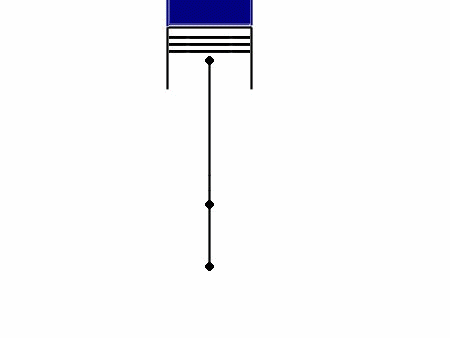|
|
Forces and torques in the
crankshaft mechanism

The highest forces on the crankshaft result from the combustion of the fuel-air mixture. The tilting of the engine, to support itself against the
rotation direction of
the output shaft(s), is the torque on the crankshaft caused by the combustion. However, an engine also moves even though delivering no usable torque, e.g., when idling.
The oscillations in the direction of piston travel, particularly in single-cylinder engines are obvious here. Although, even if the stroke movements in a multi-cylinder engine are compensated, the piston engine still
moves slightly to-and-fro on its crankshaft axis. The respective oscillation reaches its climax when the lower part of the connecting rod and thus the crankshaft, shows the maximum deflection. More precisely, when the
angle of the crank-throw from the center of the big-end is 90° to the center line of the connecting rod.
One should distinguish between gas-forces and inertial-forces. Inertial-forces develop from the imbalance of rotating parts and also occur from to-and-fro moving masses which cannot be compensated at all or not at
the same place. Gas-forces develop from the increase in pressure caused by the combustion and act in all directions evenly.
If one assumes the same pressure, the gas-forces acting on the piston are proportional to its surface area. One could also say, they increase with the square-area of the bore. They are however, perceptible rather at
low engine RPMs. Above that, they are mostly overlaid by the already mentioned momentums. Thus, one may notice when idling, that e.g., through a defect, the vibrations of individual cylinders slightly differ during
ignition.
Possible alternatives to the thrust-crank-mechanism have not been able to assert themselves. Whereby, all together, rather more problems arose with the gear-rack of the atmospheric
gas engine and also with the ingenious solution of the rotary engine than fewer. There have even been engines without connecting rods and
crankshaft which transmitted
their force hydraulically.
No, it would seem that there is no alternative to the crank mechanism, even though its disadvantages, like having pistons and parts of the connecting rod constantly changing between maximum speed and brief
shutdown periods, appear to predominate. One has learned how to manage it. Even the changeover of the piston from one side to the other is placed in that part of the movement which is under less pressure from
the combustion chamber (see axial offsetting).
The gas force is transferred through the piston to the connecting-rod. This is, at the beginning of the power-stroke, still relatively vertical. In its further course of travel, and with probably still increasing gas force, the
angle of slant becomes larger. This is dependent, by the way, with the otherwise same measurements, on the length of the connecting rod. The longer it is, the less lateral force is placed on the cylinder wall by the
piston. Indeed, long connecting rods make the construction height of the engine higher which complicates its accommodation.
At least with a short connecting rod, the right angle state between the connecting rod and the crank-journal is reached after a substantially shorter piston-travel, which increases the effectivness of the transmission of
the gas forces which are still particularly high in this area. Should you be interested in the calculation of forces, we refer you to the suitable section of our
crankshaft drive. 05/10
|
|